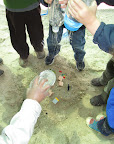On behalf of the staff of the National Science Teachers Association (NSTA) and our leadership team, I would like to thank the following members of our Board, Council, Standing Committees, Advisory Boards, and Panels whose terms of appointment end on May 31, 2013. NSTA is shaping the next generation of science education, and the experience, wisdom, and willingness of the following individuals to volunteer their time has been pivotal in guiding us in the past year. The theme of my presidency is “Build the Scaffolding for 21st Century Science Literacy,” and it’s been an amazing journey and a privilege to have them at my side throughout my tenure. So, to all of you on the list below, I say “Thank You” and I look forward to working with you in new capacities in the years to come.
NSTA members who are interested in volunteering for a position on one our committees, advisory boards, or review panels can find more information at http://www.nsta.org/involved/default.aspx#committees.
—Karen L. Ostlund, NSTA President, 2012–2013
Board of Directors
Michael Lowry, Chattanooga, TN
Thomas Lord, Indiana, PA
Linda Lacy, Excelsior Springs, MO
Council
Gloria Allen, Washington, DC
Cynthia Willingham, Vestavia Hills, AL
Ramona Lundberg, Clear Lake, SD
Sally Harms, Wisner, NE
John Graves, Bozeman, MT
Jennifer Thompson, Juneau, AK
Standing Committees
College
Thomas Lord, Indiana, PA
David Crowther, Reno, NV
Suzanne Gould, Anderson, IN
Oliver Grundmann, Chandler, AZ
Coordination and Supervision
Jo-Ne Bourassa, Macon, GA
Joseph Kelly, Meridian, ID
Michael Szydlowski, Columbia, MO
Linda Lacy, Excelsior Springs, MO
High School
Michael Lowry, Chattanooga, TN
Gail Hall, Montpelier, VT
Kerryane Monahan, Ft. Pierce, FL
Eric Walters, New York, NY
Informal
Laurie Stuart, Seward, AK
Brad Tanner, Sarasota, FL
Middle Level
Scott Diamond, Lexington, KY
Amy Hunt, Chula Vista, CA
Alison Seymour, Rancho Palos Verdes, CA
Multicultural/Equity
Toni Carmichael, Lake Forest, IL
Maya Garcia, Washington, DC
Sheila Smith, Ridgeland, MS
Preschool-Elementary
Cathy Jamison, Wake Forest, NC
Michael Szydlowski, Columbia, MO
Jennifer Williams, Belle Chasse, LA
Preservice Teacher Preparation
Chelsea Ann Duhon, Baton Rouge, LA
Timothy A. Laubach, Norman, OK
Eric J. Pyle, Harrisonburg, VA
Cathy Wissehr, Fayetteville, AR
Professional Development
Jeanne Fox, Chickasaw, AL
Eric Hadley, Florissant, MO
Barbara Tharp, Houston, TX
Research
Mary Atwater, Athens, GA
Jacqueline McDonnough, Richmond, VA
Barry Thompson, Evans, GA
Awards and Recognition
Peggy Carlisle, Flowood, MS
Craig Gabler, Tumwater, WA
Karen Maher, Juneau, AK
Jean Tushie, Eden Prairie, MN
Candace Lutzow-Felling, Boyce, VA
Budget and Finance
Peter McLaren, Providence, RI
Barbara Pietrucha, Point Pleasant, NJ
Nominations
Mary Louise Bellamy, Cary, NC
Annette Barzal, Medina, OH
Rita Hagevik, Wendell, NC
Cecilia Owens, Westborough, MA
Maryann Stimmer, New York, NY
Advisory Boards
Aerospace
Eric Brunsell, Oshkosh, WI
Steve Heck, Loveland, OH
James Kuhl, Central Square, NY
Conference
Carolyn Hayes, Greenwood, IN
Development
Michelle Ellis, Gastonia, NC
Linda Froschauer, Westport, CT
International
Julie Heintz, Calumet City, IL
Mary McDougall, Calgary, AB, Canada
Alison Seymour, Rancho Palos Verdes, CA
Investment
Ruth Ruud, Fairview, PA
Journal of College Science Teaching
Marshall Sundberg, Emporia, KS
Eliza Richardson, University Park, PA
Mark Turski, Plymouth, NH
NSTA Reports
Stephen Crandall, Inverness, FL
Jeanelle Day, Willimantic, CT
Deborah Tucker, Napa, CA
Michael Lowry, Chattanooga, TN
Retired Members
Robin Curtis, Williamsburg, VA
John Jackson, Altadena, CA
Mary Strother, Glen Allen, VA
Science&Children
Jessica Fries-Gaither, Hilliard, OH
Elizabeth Barrett-Alexander, New Rochelle, NY
Todd Hoover, Halifax, PA
Science Matters
David Bydlowski, Livonia, MI
Eric Packenham, Logan, UT
Science Safety
Jeri Leonard, Wylie, TX
Science Scope
Sandy Buczynski, San Diego, CA
Kimberly Lightle, Columbus, OH
C. Anne Wallen, Winston-Salem, NC
Special Needs
Kahille Dorsinvil, Medford, NY
Maya Israel, Cincinnati, OH
Mary Beth Katz, Birmingham, AL
Sally Harms, Wisner, NE
Technology
Andrea Ellinger, Seattle, WA
Caryn Meirs, Smithtown, NY
Manorama Talaiver, Chesterfield, VA
The Science Teacher
Pradeep Dass, Boone, NC
Joel Gluck, Cranston, RI
George Griffith, Almena, KS
Michael Lowry, Chattanooga, TN
Urban Science
Martha Day, Bowling Green, KY
David Miller, Las Vegas, NV
Theresa Robinson Thomas, Chicago, IL
Gloria Allen, Washington, DC
Panels
NSTA/CBC Review
Betty Crocker, Denton, TX
Sharla Dowding, Newcastle, WY
Steve Rich, Douglasville, GA
New Science Teachers Academy
Joyce Gleason, Punta Gorda, FL
Timothy Laubach, Norman, OK
Janet Magargal, Drexel Hill, PA
Shell Science Teaching Award Judging
Deborah Cornelison, Ada, OK
Hubert Dyasi, Yonkers, NY
John Jackson, Altadena, CA



 Knockoffs. You can buy them anywhere—from a street vendor, a flea market, or the local discount shop. But what if you’ve decided to pay more for the “real thing”? How can you be sure you’re getting the handbag, shoes, device, or even medication you’re paying for?
Knockoffs. You can buy them anywhere—from a street vendor, a flea market, or the local discount shop. But what if you’ve decided to pay more for the “real thing”? How can you be sure you’re getting the handbag, shoes, device, or even medication you’re paying for?
 You’re celebrating a romantic little restaurant or some other special place. Your significant other presents you with a small velvet box containing a huge diamond ring or flawless diamond cuff links. Would you like the sparkling gems any less if you knew they came from a lab and not a diamond mine?
You’re celebrating a romantic little restaurant or some other special place. Your significant other presents you with a small velvet box containing a huge diamond ring or flawless diamond cuff links. Would you like the sparkling gems any less if you knew they came from a lab and not a diamond mine?




